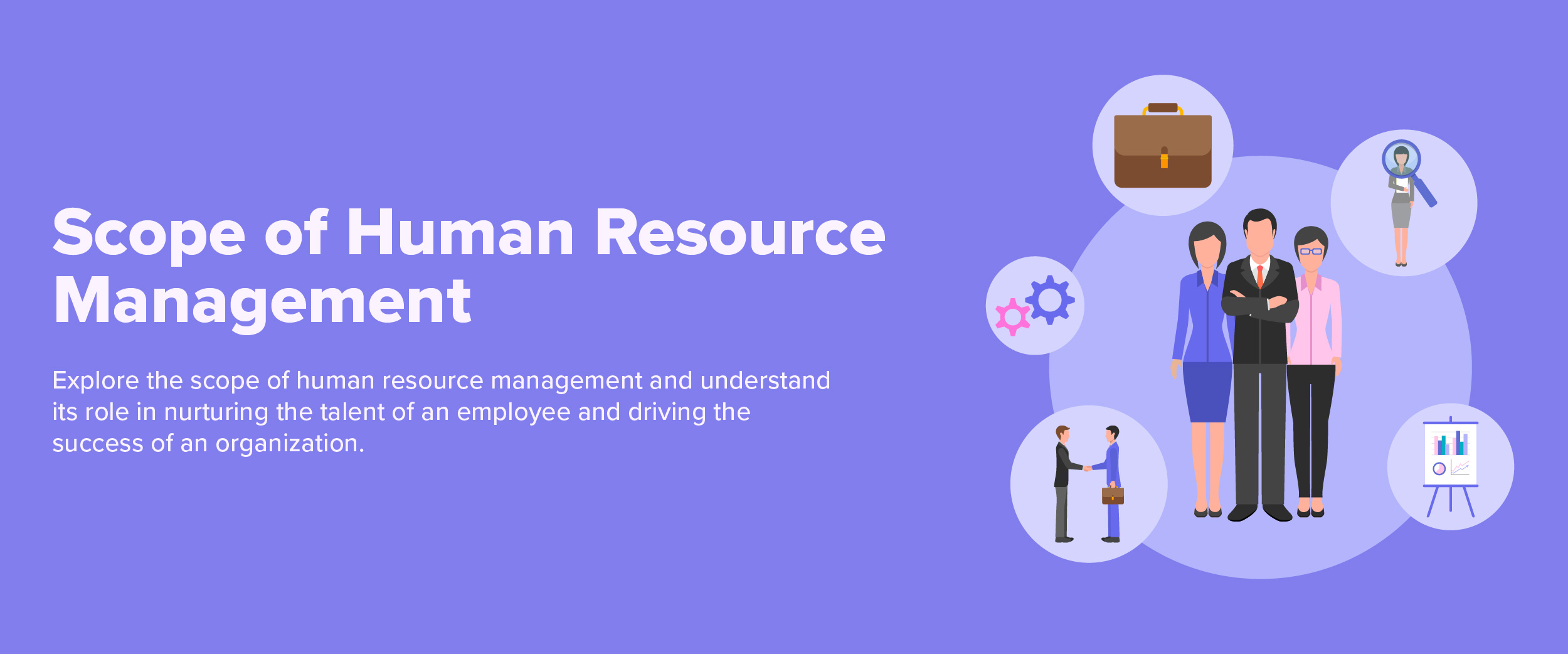Scope Of Human Resource Management (HRM)
According to a study, 34% of employees tend to leave their jobs if they feel undervalued. Employees are one of the most valuable assets of an organization. The Human Resources (HR) department is responsible for managing the workforce of an organization. Its responsibility ranges from managing employee work-life cycle to maintaining a positive company culture. Together, these responsibilities form human resource management.
In this blog, we will discuss the scope of human resource management, including hiring, training, and distributing salaries of the employees of a company.
What is Human Resources?
Human resources is the department that takes care of all the issues related to the employees of an organization. Human resources professionals are responsible for several tasks, which are as follows:
- Analyzing the company’s needs.
- Hiring talent as per the company’s needs.
- Orientation and the induction of new employees.
- Training and development of employees.
- Taking care of salaries and reimbursements.
- Inculcating the company’s culture and values.
Overall, they are concerned with the selection, job satisfaction, and retention of employees. Various job roles in human resources include HR manager, HR executive, HR recruiter, HR generalist, HR assistant, HR intern, and more. To learn more about what is the scope of human resource management, you can check out this HRM course with guaranteed placement!
10 Important Scope of Human Resource Management (HRM)
The scope of HRM includes several aspects. Some of them are:
1. Human Resource Planning
This is a step through which the human resource department identifies the needs of a company. HR planning can include identifying departments that are understaffed as well as those that are overstaffed.
2. Job Analysis Design
Job analysis involves identifying what is required to do a particular job. This includes identifying and outlining the skills needed to do that job, the nature of the job, and what other responsibilities will come with that job. This helps in writing job descriptions for different job roles.
Also Read: HR Interview Questions
3. Recruitment and Selection
After the job analysis is done and the job requirements are made, the process of recruitment starts. The hiring experts first post a job online to attract quality candidates. Once there is a certain number of candidates, the selection is made based on the qualifications and skill sets.
4. Induction and Orientation
Once the candidate is selected, an induction or orientation session is conducted. This includes introducing them to the company’s work culture and the team they will be working with. To make the candidate feel at ease, the HR staff strives to perform this in a casual setting.


5. Training and Development
Once the new employee joins, training sessions are conducted to train them according to the needs of the company. Existing employees can also be made part of these training sessions from time to time.
6. Performance Appraisal
After the candidate has spent a certain time on the job, a performance appraisal is conducted to evaluate their performance. Based on these appraisals, salaries are updated and further training sessions are conducted.
7. Remuneration
Remuneration helps in boosting employee morale and promoting a positive work environment. The employees who perform well are rewarded with incentives and other benefits.
8. Motivation, Welfare, and Safety
To retain employees and promote a healthy work culture, an organization needs to ensure its employees stay motivated. This motivation can be in the form of monetary benefits, promotions, rewards, or recognition.
HRM also encompasses the welfare of employees, which includes providing medical aid, transportation facilities, housing facilities, daycare centers for the employees’ children, etc. Further, safety regulations, regular audits, risk assessment, and implementation of corrective measures promote the safety and well-being of the employees.
9. Industrial Relations
Organizations have to follow industrial compliances as specified by the competent authorities. The HR department helps the company and its employees adhere to these compliances, labor laws, and safety regulations to avoid legal issues or fines and stay productive in the long run.
10. Employee Grievance
The scope of human resource management encompasses employee grievance redressal. They take regular employee feedback to understand any difficulties these employees might be facing and make the work conditions better. Confidentiality is preferred in this process to maintain trust with the employees. It helps them feel secure in sharing their concerns about the workplace, team, or tasks.


Conclusion
In this fast-paced and competitive environment, building a positive, healthy, and safe workspace is of utmost importance to attract the best talent. The nature and scope of HRM are wide-ranging, comprising several aspects from developing a recruitment strategy to training new employees. It also entails addressing employee grievances, while managing performance appraisals and remuneration. Overall, the scope of human resource management continues to evolve and match the needs of the organization.
Which aspect do you think is the most essential for the HR division of an organization? Share your thoughts with us in the comments section below. Also, check out the top HR interview questions if you plan on applying for HR jobs.
FAQs
Yes, there is ample scope in the HR field. You can find many job opportunities and a handsome salary package in this field.
Yes, there is ample scope in the HR field. You can find many job opportunities and a handsome salary package if you work in the HR field.
The seven functions of HR include recruitment and selection, training and development, employee relations, performance management, administration and payroll systems, employment law and compliance, and compensation and benefits.
The five components of HRM are core HR functions, recruitment and onboarding, workforce management, talent management, and learning management.
The four types of human resources are full-time employees, part-time employees, contract workers, and consultants.
The six elements of HR include recruitment and selection, training and development, performance management, compensation and benefits, employee relations, and HR planning and strategy.
Understanding the importance of HRM allows you to effectively organize and develop an organization’s workforce. They acquire new talent, train them, and resolve conflicts to maintain employee relations. It contributes to a positive work culture necessary for an organization’s success.







